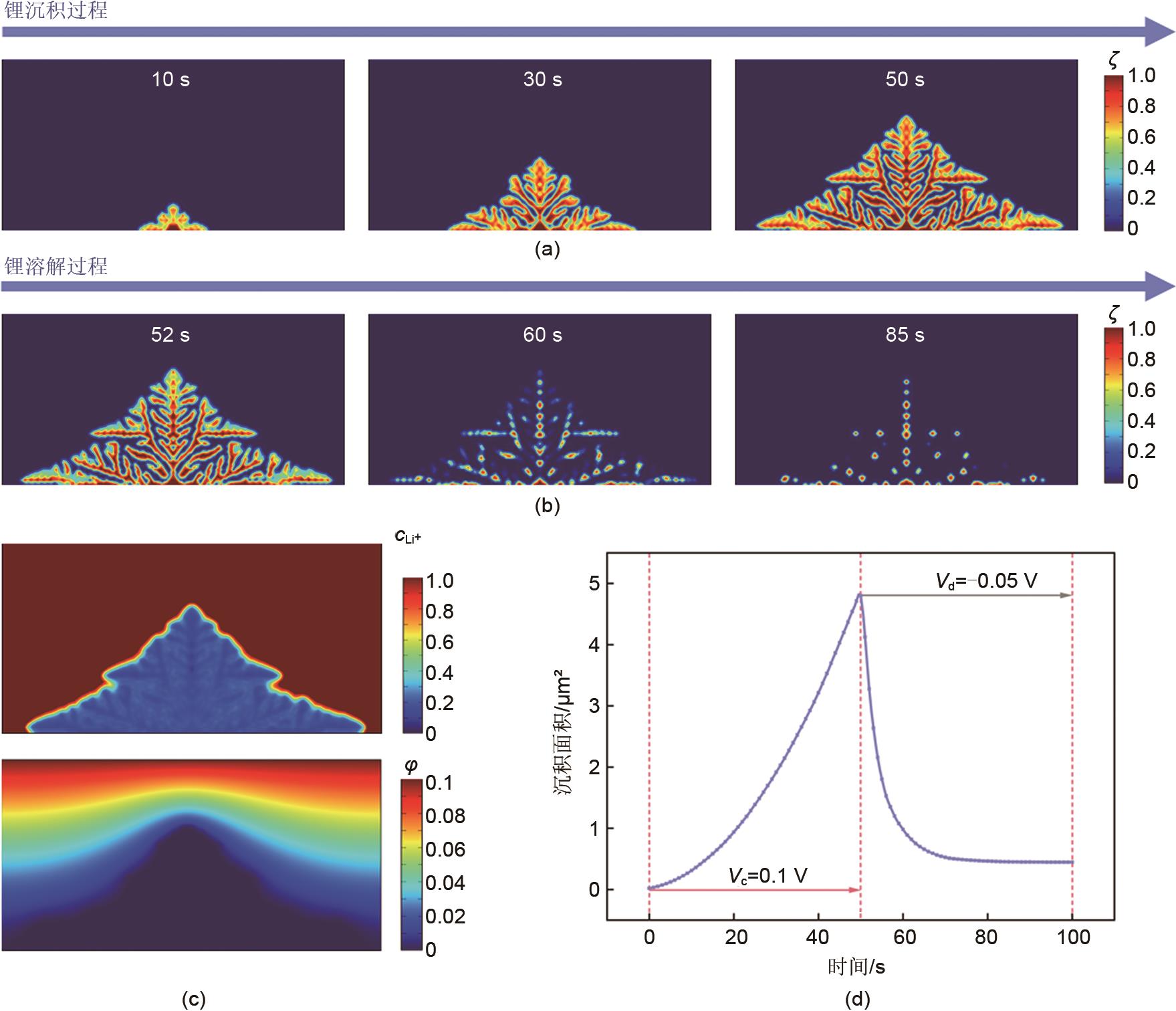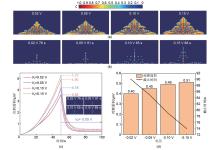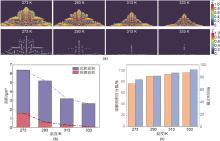Energy Storage Science and Technology ›› 2025, Vol. 14 ›› Issue (5): 1829-1840.doi: 10.19799/j.cnki.2095-4239.2024.1125
• Energy Storage Materials and Devices • Previous Articles Next Articles
Chen LIANG1( ), Pengfei XING2, Mengwu WU1,3(
), Pengfei XING2, Mengwu WU1,3( ), Xunpeng QIN3
), Xunpeng QIN3
Received:2024-11-27
Revised:2024-12-16
Online:2025-05-28
Published:2025-05-21
Contact:
Mengwu WU
E-mail:whutliangchen@163.com;wumw@whut.edu.cn
CLC Number:
Chen LIANG, Pengfei XING, Mengwu WU, Xunpeng QIN. Phase-field simulation study on the growth and dissolution of lithium dendrites during the charging and discharging processes of lithium metal batteries[J]. Energy Storage Science and Technology, 2025, 14(5): 1829-1840.
Table 1
Parameters used in numerical model[32][35]"
| 参数符号 | 描述 | 数值[单位] |
|---|---|---|
| 各向异性强度 | 0.1 | |
| 各向异性模数 | 4 | |
| 界面迁移率 | 2.5E-6[ | |
| 反应速率系数 | 1.0[ | |
| 对称因子 | 0.5 | |
| 电极Li+扩散系数 | 7.5E-13[ | |
| 电解质Li+扩散系数 | 7.5E-10[ | |
| 电极离子电导率 | 1.0E7[ | |
| 电解质离子电导率 | 1.0[ | |
| 势垒高度 | 3.75E5[ | |
| 电极比热容 | 3600[ | |
| 电解质比热容 | 1200[ | |
| 电极密度 | 590 | |
| 电解质密度 | 1290 | |
| 电极热导率 | 84.8[ | |
| 电解质热导率 | 0.45[ | |
| h | 对流换热系数 | 10[ |
| 发射速率 | 0.49 | |
| Stephen-Boltzmann常数 | 5.67E-8[ | |
| 活化能 | 3.3E4[ |

Fig. 2
Evolution of lithium dendrite morphology during charging and discharging process: (a) Lithium dendrite growth during charging process; (b) Lithium dendrite dissolution during discharging process; (c) Lithium concentration distribution and potential distribution at 50 s; (d) Lithium deposition area during charging and discharging process"


Fig. 3
Influence of charge and discharge voltage on the growth and dissolution of lithium dendrites: (a) Dendrite morphology when lithium deposition reaches its peak at different charging voltages; (b) Morphology of dead lithium under the same discharge voltage and different charging voltage; (c) Lithium deposition area under the same discharge voltage and different charging voltages; (d) Dead lithium area and lithium dissolution cut-off time under the same charging voltage but different discharging voltages"


Fig. 8
Lithium dendrite growth and dissolution at different temperatures: (a) Lithium dendrite morphology at the end of charging and dead lithium morphology at the end of discharging; (b) Lithium deposit area at the end of charging and dead lithium area at the end of discharging; (c) Percentage of lithium dissolution area and dissolution cut-off time"

| 1 | DEGEN F, WINTER M, BENDIG D, et al. Energy consumption of current and future production of lithium-ion and post lithium-ion battery cells[J]. Nature Energy, 2023, 8(11): 1284-1295. DOI: 10. 1038/s41560-023-01355-z. |
| 2 | 石敏, 蒋鹏杰, 徐琛, 等. 抑制锂金属负极枝晶的电解液调控策略[J]. 储能科学与技术, 2024, 13(5): 1620-1634. DOI: 10.19799/j.cnki. 2095-4239.2023.0892. |
| SHI M, JIANG P J, XU C, et al. Advancements in electrolyte optimization strategies for inhibiting lithium dendrite growth[J]. Energy Storage Science and Technology, 2024, 13(5): 1620-1634. DOI: 10.19799/j.cnki.2095-4239.2023.0892. | |
| 3 | XU H Y, HAN C, LI W T, et al. Quantification of lithium dendrite and solid electrolyte interphase (SEI) in lithium-ion batteries[J]. Journal of Power Sources, 2022, 529: 231219. DOI: 10.1016/j.jpowsour.2022.231219. |
| 4 | WEI Z W, WANG X, ZHOU M J, et al. Revitalizing lithium metal batteries: Strategies for tackling dead lithium formation and reactivation[J]. Small, 2024, 20(51): e2407395. DOI: 10.1002/smll.202407395. |
| 5 | LEE H G, KIM S Y, LEE J S. Dynamic observation of dendrite growth on lithium metal anode during battery charging/discharging cycles[J]. NPJ Computational Materials, 2022, 8: 103. DOI: 10.1038/s41524-022-00788-6. |
| 6 | LIU H, CHENG X B, XU R, et al. Plating/stripping behavior of actual lithium metal anode[J]. Advanced Energy Materials, 2019, 9(44): 1902254. DOI: 10.1002/aenm.201902254. |
| 7 | GAO L T, HUANG P Y, FENG J M, et al. In situ characterization and phase-filed modeling of the interaction between dendrites and gas bubbles during an electrochemical process[J]. ChemElectroChem, 2021, 8(15): 2881-2887. DOI: 10.1002/celc. 202100481. |
| 8 | XIANG S B, FU Y, YIN C R, et al. Advances in research on the inhibitory effect of 3D current collector structures for lithium dendrites[J]. Inorganic Chemistry Frontiers, 2023, 10(23): 6767-6791. DOI: 10.1039/D3QI01290E. |
| 9 | JIANG F N, YANG S J, LIU H, et al. Mechanism understanding for stripping electrochemistry of Li metal anode[J]. SusMat, 2021, 1(4): 506-536. DOI: 10.1002/sus2.37. |
| 10 | TEWARI D, MUKHERJEE P P. Mechanistic understanding of electrochemical plating and stripping of metal electrodes[J]. Journal of Materials Chemistry A, 2019, 7(9): 4668-4688. DOI: 10.1039/C8TA11326B. |
| 11 | ZHU R D, LIU C, FENG J M, et al. In situ observation of lithium dendrite of different graphite electrodes[J]. ECS Transactions, 2018, 85(13): 347-356. DOI: 10.1149/08513.0347ecst. |
| 12 | 丰闪闪, 刘晓斌, 郭石麟, 等. 锂枝晶的成核、生长与抑制[J]. 化工学报, 2022, 73(1): 97-109. DOI:10.11949/0438-1157.20211241 |
| 13 | 苑志祥, 张雅岚, 张浩, 等. 高杨氏模量细菌纤维素隔膜有效抑制锂枝晶[J]. 化学学报, 2024, 82(8): 849-855. DOI: 10.6023/A24040141 |
| 14 | ZHANG L Q, YANG T T, DU C C, et al. Lithium whisker growth and stress generation in an in situ atomic force microscope-environmental transmission electron microscope set-up[J]. Nature Nanotechnology, 2020, 15(2): 94-98. DOI: 10.1038/s41565-019-0604-x. |
| 15 | FANG C C, LU B Y, PAWAR G, et al. Pressure-tailored lithium deposition and dissolution in lithium metal batteries[J]. Nature Energy, 2021, 6(10): 987-994. DOI: 10.1038/s41560-021-00917-3. |
| 16 | KONG L X, XING Y J, PECHT M G. In-situ observations of lithium dendrite growth[J]. IEEE Access, 2018, 6: 8387-8393. |
| 17 | DACHRAOUI W, KÜHNEL R S, BATTAGLIA C, et al. Nucleation, growth and dissolution of Li metal dendrites and the formation of dead Li in Li-ion batteries investigated by operando electrochemical liquid cell scanning transmission electron microscopy[J]. Nano Energy, 2024, 130: 110086. DOI: 10.1016/j.nanoen.2024.110086. |
| 18 | DING X, CHEN Y W, GUO Y Z, et al. In-situ observation of lithium plating and stripping by synchrotron-based soft X-ray microscopy[J]. Journal of Power Sources, 2024, 609: 234571. DOI: 10.1016/j.jpowsour.2024.234571. |
| 19 | SHEN X, ZHANG R, WANG S H, et al. The dynamic evolution of aggregated lithium dendrites in lithium metal batteries[J]. Chinese Journal of Chemical Engineering, 2021, 37: 137-143. DOI: 10. 1016/j.cjche.2021.05.008. |
| 20 | LIU H W, JIANG W N, CHEN W J, et al. Dendrite growth and inhibition in all-solid-state lithium metal batteries: in situ optical observation[J]. Journal of Materials Chemistry A, 2024, 12(6): 3575-3579. DOI: 10.1039/D3TA07366A. |
| 21 | ARGUELLO M E, LABANDA N A, CALO V M, et al. Dendrite formation in rechargeable lithium-metal batteries: Phase-field modeling using open-source finite element library[J]. Journal of Energy Storage, 2022, 53: 104892. DOI: 10.1016/j.est. 2022. 104892. |
| 22 | JING H X, XING H, DONG X L, et al. Nonlinear phase-field modeling of lithium dendritic growth during electrodeposition[J]. Journal of the Electrochemical Society, 2022, 169(3): 032511. DOI: 10.1149/1945-7111/ac5fed. |
| 23 | LI Y J, SHA L T, ZHANG G, et al. Phase-field simulation tending to depict practical electrodeposition process in lithium-based batteries[J]. Chinese Chemical Letters, 2023, 34(2): 107993. DOI: 10.1016/j.cclet.2022.107993. |
| 24 | KO C J, TAI C N, CHEN C H, et al. Influence of concentration-dependent diffusivity on lithium plating: Polarization, stability, and dendrite formation in phase-field simulations[J]. Journal of Energy Storage, 2024, 97: 112615. DOI: 10.1016/j.est. 2024. 112615. |
| 25 | ZHANG J W, LIU Y P, WANG C G, et al. An electrochemical-mechanical phase field model for lithium dendrite[J]. Journal of the Electrochemical Society, 2021, 168(9): 090522. DOI: 10.1149/1945-7111/ac22c7. |
| 26 | ZHANG R, SHEN X, ZHANG Y T, et al. Dead lithium formation in lithium metal batteries: A phase field model[J]. Journal of Energy Chemistry, 2022, 71: 29-35. DOI: 10.1016/j.jechem.2021.12.020. |
| 27 | PANT B R, REN Y, CAO Y. Dendrite growth and dead lithium formation in lithium metal batteries and mitigation using a protective layer: A phase-field study[J]. ACS Applied Materials & Interfaces, 2024, 16(42): 56947-56956. DOI: 10.1021/acsami. 4c08605. |
| 28 | GAO L T, LYU Y H, GUO Z S. External pressure affecting dendrite growth and dissolution in lithium metal batteries during cycles[J]. ACS Applied Materials & Interfaces, 2023, 15(50): 58416-58428. DOI: 10.1021/acsami.3c13972. |
| 29 | YANG H D, WANG Z J. Effects of pressure, temperature, and plasticity on lithium dendrite growth in solid-state electrolytes[J]. Journal of Solid State Electrochemistry, 2023, 27(10): 2607-2618. DOI: 10.1007/s10008-023-05560-4. |
| 30 | QIAO D G, LIU X L, DOU R F, et al. Quantitative analysis of the inhibition effect of rising temperature and pulse charging on Lithium dendrite growth[J]. Journal of Energy Storage, 2022, 49: 104137. DOI: 10.1016/j.est.2022.104137. |
| 31 | QI G Q, LIU X L, DOU R F, et al. A three-dimensional multiphysics field coupled phase field model for lithium dendrite growth[J]. Journal of Energy Storage, 2024, 101: 113899. DOI: 10.1016/j.est.2024.113899. |
| 32 | CHEN C H, PAO C W. Phase-field study of dendritic morphology in lithium metal batteries[J]. Journal of Power Sources, 2021, 484: 229203. DOI: 10.1016/j.jpowsour.2020.229203. |
| 33 | MU Z L, GUO Z P, LIN Y H. Simulation of 3-D lithium dendritic evolution under multiple electrochemical states: A parallel phase field approach[J]. Energy Storage Materials, 2020, 30: 52-58. DOI: 10.1016/j.ensm.2020.04.011. |
| 34 | LI Y J, SHA L T, LV P L, et al. Influences of separator thickness and surface coating on lithium dendrite growth: A phase-field study[J]. Materials, 2022, 15(22): 7912. DOI: 10.3390/ma15227912. |
| 35 | CHEN L, ZHANG H W, LIANG L Y, et al. Modulation of dendritic patterns during electrodeposition: A nonlinear phase-field model[J]. Journal of Power Sources, 2015, 300: 376-385. DOI: 10.1016/j.jpowsour.2015.09.055. |
| 36 | JIANG W J, WANG Z H, HU L Z, et al. Simulations of dendrite and crack and their interactions in solid electrolyte by phase field method[J]. Journal of Energy Storage, 2024, 86: 111126. DOI: 10. 1016/j.est.2024.111126. |
| 37 | YAN H H, BIE Y H, CUI X Y, et al. A computational investigation of thermal effect on lithium dendrite growth[J]. Energy Conversion and Management, 2018, 161: 193-204. DOI: 10.1016/j.enconman.2018.02.002. |
| 38 | 乔东格, 刘训良, 温治, 等. 升温和脉冲充电对锂枝晶生长抑制作用的数值分析[J]. 储能科学与技术, 2022, 11(3): 1008-1018. DOI: 10.19799/j.cnki.2095-4239.2021.0629. |
| QIAO D G, LIU X L, WEN Z, et al. Numerical analysis of inhibition of lithium dendrite growth by heating and pulse charging[J]. Energy Storage Science and Technology, 2022, 11(3): 1008-1018. DOI: 10.19799/j.cnki.2095-4239.2021.0629. | |
| 39 | ZHANG Y X, LI Y F, SHEN W J, et al. Important role of atom diffusion in dendrite growth and the thermal self-healing mechanism[J]. ACS Applied Energy Materials, 2023, 6(3): 1933-1945. DOI: 10.1021/acsaem.2c03864. |
| 40 | PARK M S, MA S B, LEE D J, et al. A highly reversible lithium metal anode[J]. Scientific Reports, 2014, 4: 3815. DOI: 10.1038/srep03815. |
| 41 | STEIGER J, KRAMER D, MÖNIG R. Microscopic observations of the formation, growth and shrinkage of lithium moss during electrodeposition and dissolution[J]. Electrochimica Acta, 2014, 136: 529-536. DOI: 10.1016/j.electacta.2014.05.120. |
| 42 | STEIGER J, KRAMER D, MÖNIG R. Mechanisms of dendritic growth investigated by in situ light microscopy during electrodeposition and dissolution of lithium[J]. Journal of Power Sources, 2014, 261: 112-119. DOI: 10.1016/j.jpowsour. 2014. 03.029. |
| 43 | HARRIS S J, TIMMONS A, BAKER D R, et al. Direct in situ measurements of Li transport in Li-ion battery negative electrodes[J]. Chemical Physics Letters, 2010, 485(4/5/6): 265-274. DOI: 10.1016/j.cplett.2009.12.033. |
| [1] | Dequan HUANG, Tao WEI, Guangda YIN, Gang WEN, Jue HOU, Yi LIANG. Research on the application of siloxane solvent in high-voltage lithium metal batteries and electrochemical performance [J]. Energy Storage Science and Technology, 2025, 14(4): 1340-1351. |
| [2] | Gongxun LU, Huadong YUAN, Jianmin LUO, Yao WANG, Yujing LIU, Peng SHI, Shihui ZOU, Guangmin ZHOU, Xinyong TAO, Jianwei NAI. Surface pre-treatment strategies for lithium metal: Advancement and perspective [J]. Energy Storage Science and Technology, 2025, 14(3): 947-964. |
| [3] | Yajie LI, Yiping WANG, Bin CHEN, Hailong LIN, Geng ZHANG, Siqi SHI. Machine learning-assisted phase-field simulation for predicting the impact of lithium-ion transport parameters on maximum battery dendrite height and space utilization rate [J]. Energy Storage Science and Technology, 2024, 13(9): 2864-2870. |
| [4] | Qi SUN, Hao PENG, Qingguo MENG, Dekai KONG, Rui FENG. Thermal adaptability of energy storage battery pack in extreme conditions [J]. Energy Storage Science and Technology, 2024, 13(6): 2039-2043. |
| [5] | Jian LIU, Libo YU, Zhenxing WU, Jiegang MOU. Effect of thermal characteristics of lithium-ion battery charging and discharging equipment on air cooling [J]. Energy Storage Science and Technology, 2024, 13(3): 914-923. |
| [6] | Yihan Li, Shigang LU, Jing WANG, Wangjun ZHA, Zhenghang DAI, Yitong GUO, Zexi YANG. Effect of irreversible lithium plating at low temperature on the performance degradation of LiFePO4 lithium-ion batteries [J]. Energy Storage Science and Technology, 2024, 13(10): 3656-3665. |
| [7] | Ye XIAO, Lei XU, Chong YAN, Jiaqi HUANG. Design and application of reference electrodes for lithium batteries [J]. Energy Storage Science and Technology, 2024, 13(1): 82-91. |
| [8] | Yu HAN, Shengling CAO, Jing NING, Kangli WANG, Kai JIANG, Min ZHOU. Strategies for interfacial modification in lithium metal batteries with polymers [J]. Energy Storage Science and Technology, 2023, 12(8): 2491-2503. |
| [9] | Xin SHEN, Rui ZHANG, Chenzi ZHAO, Peng WU, Yutong ZHANG, Jundong ZHANG, Lizhen FAN, Quanbing LIU, Aibing CHEN, Qiang ZHANG. Recent advances in mechano-electrochemistry in lithium metal batteries [J]. Energy Storage Science and Technology, 2022, 11(9): 2781-2797. |
| [10] | Yajie LI, Geng ZHANG, Liting SHA, Wei ZHAO, Bin CHEN, Da WANG, Jia YU, Siqi SHI. Phase-field simulation of dendrite growth in rechargeable batteries [J]. Energy Storage Science and Technology, 2022, 11(3): 929-938. |
| [11] | Luyu GAN, Rusong CHEN, Hongyi PAN, Siyuan WU, Xiqian YU, Hong LI. Multiscale research strategy of lithium ion battery safety issue: Experimental and simulation methods [J]. Energy Storage Science and Technology, 2022, 11(3): 852-865. |
| [12] | Suting WENG, Zepeng LIU, Gaojing YANG, Simeng ZHANG, Xiao ZHANG, Qiu FANG, Yejing LI, Zhaoxiang WANG, Xuefeng WANG, Liquan CHEN. Cryogenic electron microscopy (cryo-EM) characterizing beam-sensitive materials in lithium metal batteries [J]. Energy Storage Science and Technology, 2022, 11(3): 760-780. |
| [13] | Qingwen GAO, Zhihao YANG, Wenpeng LI, Wenjia WU, Jingtao WANG. Preparation and performance of Co2+-doped CeO2-based laminar composite solid-state electrolyte [J]. Energy Storage Science and Technology, 2022, 11(12): 3776-3786. |
| [14] | Yonggang LOU, Dayong WU, Boran CAI, Weihua LIANG, Luye YANG, Lei HE, Jianhua CAO. Study on preparation and performance of poly(m-phenylene isophthalamide)/solid-state ionic conductor composite membrane [J]. Energy Storage Science and Technology, 2022, 11(10): 3112-3122. |
| [15] | Xing ZHANG, Peng RUAN, Liuli ZHANG, Gangling TIAN, Baohong ZHU. Performance test of flywheel energy storage device [J]. Energy Storage Science and Technology, 2021, 10(5): 1674-1678. |
| Viewed | ||||||
|
Full text |
|
|||||
|
Abstract |
|
|||||
